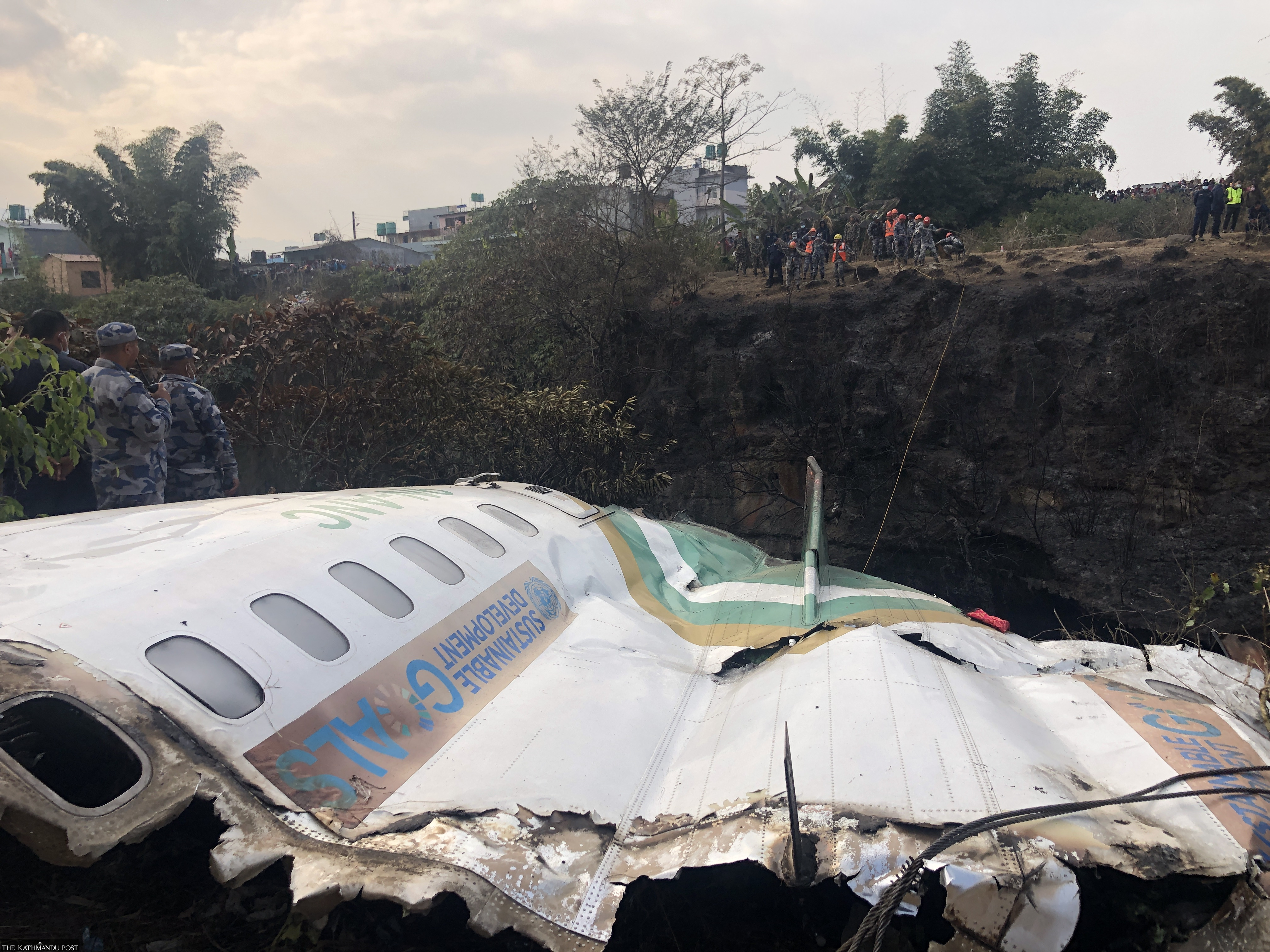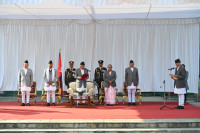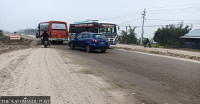National
Failure to deploy full flaps may have caused Yeti crash
Landing aircraft have flaps at the back of the wings fully deployed to provide more lift at low speed, and prevent stalling. This wasn’t the case on Sunday.
Sangam Prasain
The pilots of the Yeti Airlines ATR that crashed in Pokhara may have failed to fully deploy wing flaps while coming in to land, leading to a stall, early reports said.
Aircraft coming to land have the flaps at the back of the wings fully down to provide more control at low speed, and prevent stalling.
The exact reason behind Sunday’s Flight 961 disaster, which killed 71 people (one person is still unaccounted for), will be known after an examination of the flight data recorder, or the black box.
Preliminary reports indicate that the flaps were not fully deployed, multiple sources told the Post.
Two mobile videos went viral immediately after the crash. One showed the aircraft banking sharply left, and then falling after a stall.
The second video appeared online several hours after the incident and went viral in India. It showed an Indian passenger identified as Sonu Jaiswal live streaming from the plane seconds before it went down. The footage showed that the flaps were not fully down, leading experts to suspect that the aircraft might have stalled for this reason.
“I was stunned after watching the video,” said Kumar Pandey, a senior ATR captain. “From the window, we can clearly see that one side of the wing flap of the aircraft was not fully deployed. I speak on the basis of the video footage, which is subject to a detailed investigation.” In 2007-08, Pandey had flown this same aircraft that once belonged to the now-defunct Kingfisher Airlines of India.
“It looks like the pilots messed up. If that’s the case, it’s a big negligence. They didn’t follow the basic checklist.”
Referring to the landing checklist, the co-pilot normally reports when the aircraft has descended to 1,000 feet, the level at which the aircraft is supposed to be fully stabilised for landing.
Normally, at the speed of 160 knots or 296 kilometres per hour, the pilot releases the landing gear. At this stage, the flaps should be deployed at 15 degrees.
When the speed goes below 150 knots or 277 kilometres per hour, the flaps should be set at 30 degrees.
This process stabilises the aircraft for a smooth landing. The pilots then align the aircraft with the runway. At this phase, the flaps should be set at 30 degrees to reduce the speed.
“But the video shows the flaps at 15 degrees,” Pandey said. According to him, extending the flaps, particularly beyond 30 degrees, results in significant levels of drag.
When a steep approach angle and a short final come together, the landing becomes critical, which could be the case with the Yeti Airlines Flight 961.
Short final means the last section of the final approach. The drag results in a quick descent that must be controlled with power. A reduction in power too early results in loss of control.
“It seemed the crew forgot the flap 30 when the flight was at a low approach. This reduced the power. The pilots failed to give power,” said another ATR instructor pilot who flies outside Nepal.
This may have vibrated the stick shaker, a stall warning device used for stall avoidance.
“To recover, the plane has to make a nose down and give full power,” the instructor pilot said. “As the elevation was low, it banked and went out of control.”
“The aircraft in the video appears to be in full stall. It was too late for the flight captains to correct,” said Pandey.
The Post talked to at least four ATR captains and at least three experts who have extensive knowledge of the matter. Their common conclusion is: “The pilots may have omitted the mandatory final landing checklist.”
What happened on Sunday?
The runway of the Pokhara International Airport is 45 metres wide and 2,500 metres long, and its designation is 12-30. Runway 30 means the approach is from the eastern end and Runway 12 means the approach is from the western end.
It’s a single-approach system for international airlines, but domestic flights are allowed to land from either end.
“The weather was clear. We allocated Runway 30, which is the eastern end. Everything was fine,” Anup Joshi, spokesperson for the Pokhara International Airport, told the Post on Sunday, after the crash. He added that no problems had been reported.
The flight captain later asked for permission to switch to Runway 12 which is the western end. “We were not sure why. Permission was granted, and accordingly, the aircraft started its descent,” said Joshi who is also a senior air traffic controller.
An official at Yeti Airlines told the Post that it was a familiarisation flight for Captain Anju Khatiwada to the new international airport. She was in the left seat commanding the flight.
As per the rules, a captain needs to fly for a certain number of hours with an instructor pilot before they get to command a flight on their own. But the required number of hours varies with airlines.

Yeti requires its captains to fly 60 hours with an instructor while Buddha Air's requirement is 90 hours. Captain Khatiwada was to be cleared to perform as solo captain after Sunday’s landing.
There are personnel management problems inside Yeti Airlines as well.
In July 2019, Kathmandu’s Tribhuvan International Airport was shut down for hours after a Yeti Airlines aircraft suffered a "runway excursion" during landing.
The aircraft, on a flight from Nepalgunj, careened around 20 metres off the runway and onto the grass while landing. The pilot at the time was Pramod Poudel, who is now the operation director of Yeti Airlines.
"How can we expect proper cockpit resource management from him?” asked a senior Yeti Airlines employee who wished not to be identified.
“No wonder the company has a serious problem with its cockpit resource management and crew training.”
Sources said that some experts from ATR are scheduled to visit Yeti’s office in February to check its training manuals and resource management.
The regulator in question
The Yeti disaster is the second in under a year, highlighting the country's consistently poor air safety record, analysts said. This has put Nepal’s civil aviation authority in doubt too. Many have questioned the intent of the regulator behind opening the airport in haste.
“The airport was hastily inaugurated and operated without adequate preparations to meet the January 1 project deadline. Flight calibration, which tests all pieces of equipment at the new airport, has not recommended landing from the west,” an expert told the Post in a recent interview.
“The flight procedure has not been published. Airlines have very little information about airport procedures and data.”
Experts have also pointed out some serious lapses at the new airport.
An official at the Civil Aviation Authority said that the new airport lacks a grid map, which is required to show how fire-fighters will reach a particular area by the fastest means as per International Civil Aviation Organisation requirements.
“Fire-fighters reached the crash site after 30 minutes. That’s too long. Many people died because there was no proper planning,” said an official at the civil aviation body. “That’s utter carelessness because there is no prompt emergency response even near the international airport. Forget about other places.”
“Obviously, Nepal’s aviation system is not up to the mark. I lost my son in a crash,” said retired captain Rajan Manandhar, whose son, Srijan, died in 2017 in a Goma Air crash at Lukla airport. Manandhar had also trained Captain Kamal KC, the instructor on the ill-fated flight on Sunday.

“It’s heartbreaking to see instructor pilots, the teacher, dying. Why? Who is responsible? My son died because rescuers got to him too late. He was trapped inside the wreck for two hours. No one responded,” said Manandhar.
“There are many problems in the aviation industry. And it needs a complete overhaul,” said Manandhar. “But this is not possible as long as there are greedy politicians.”
The air traffic controller at a new airport should also have a specific rating. But in Pokhara, no one has it.
“How did the air traffic controller at the new airport get the rating and under which law?” said the civil aviation official. “There are holes everywhere. That’s how the safety system is compromised.”
The Post caught up with Ram Bahadur KC, an uncle of captain Kamal KC, at the TU Teaching Hospital where he had come to pick up his nephew’s body on Tuesday.
“We lost everything. So did others. My nephew was one of the most experienced pilots,” he said. “He is no more now.”




 9.12°C Kathmandu
9.12°C Kathmandu















